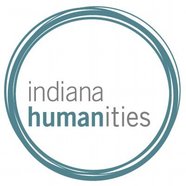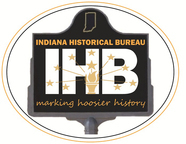|
Fall 2016 | News from the Indiana Historical Bureau
 Bilby Steel Tower
On November 5, 2016, the state historical marker honoring the Bilby Steel Tower was dedicated in Osgood, Indiana. The marker examines the tower's revolutionary impact on the accuracy and
efficiency of geodetic mapping, which served as a foundation to GPS navigation. It also
recognizes the science behind surveying, and its impact on
transportation, land use, technology, and the economy. IHB thanks the Surveyors Historical Society for applying for this marker and helping to plan the dedication ceremony. The marker text reads:
Jasper
Sherman Bilby, internationally known surveyor, moved to Ripley County by 1893.
Joined U.S. Coast and Geodetic Survey in 1884. He performed geodetic surveys,
accounting for the curvature of the earth, for commercial and infrastructure
purposes. Invented Bilby Steel Tower, 1926-27; improved efficiency and cost.
Herbert Hoover commended Bilby’s invention in 1927. Bilby’s tower allowed
surveyors to sight over obstacles when measuring long distances. Made of steel
instead of wood, they were reusable, portable, and quickly assembled. Saved
federal government $3,072,000 within first ten years of use. Used nationally
and internationally for over 50 years; the resulting data served as foundation
to modern mapping and GPS.
Find out more about Bilby's interesting career through our Blogging Hoosier History posts by Justin Clark, Jasper Sherman Bilby: To Map the Earth Part I and Part II.
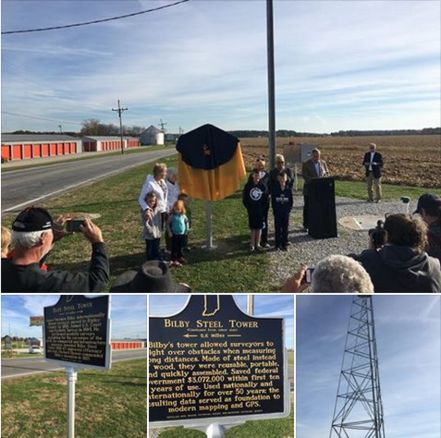
  Senate Avenue YMCA
On October 20, the state historical marker commemorating the Senate Avenue YMCA was dedicated in Indianapolis. The YMCA of Greater Indianapolis sponsored this marker and planned the dedication. Despite the cold and rain, nearly 60 people showed up for the ceremony. The event was also covered by WISH-TV. The marker text reads:
African-American
leaders formed the Young Men’s Prayer Band in 1900. It became a branch
of the city YMCA by 1910. Black and white leaders helped raise funds for
a new building here, which opened as the Senate Avenue YMCA in 1913.
Booker T. Washington dedicated the building and Faburn DeFrantz led it
from 1916-1951. It became one of the largest black YMCAs in the U.S. The
Senate Avenue YMCA became a center of community life, social activism,
and education for African Americans. For decades, it sponsored “Monster
Meetings” with national leaders including Martin Luther King, Jr.,
W.E.B. Du Bois, George Washington Carver, and Eleanor Roosevelt. The
Indianapolis YMCA integrated in 1950. The Senate Avenue YMCA moved to
Fall Creek in 1959.
 Central State Hospital
On October 6, the state historical marker commemorating Central State Hospital was dedicated in Indianapolis, with approximately 50 people attending the event. IHB would like to thank the Indiana Medical History Museum for applying for this marker.
The marker text reads:
People
with mental illness were confined to jails and almshouses, often
suffering neglect, before Dr. John Evans and local physicians advocated
for their treatment; 1840s state laws established hospital here. In
1848, first patients admitted to Indiana Hospital for the Insane;
treated for mental illness and addiction. Farm colony work and
recreation used as therapy. Since hospital’s opening, lack of funding
and understaffing led to patient abuse and neglect; Superintendent Dr.
Fletcher attempted to rectify this and burned patient restraints in a
bonfire, 1883. Groundbreaking pathology lab opened 1896, served as state
teaching hospital. Renamed Central State Hospital in 1927. Closed in
1994 with the goal of community-based care.
 James Overall
On September 29, the state historical marker honoring James Overall was dedicated in Indianapolis. A ceremony was held inside the Madame Walker Theatre to discuss Overall's significance and the importance of the marker. Thanks to Maxine Brown and the Society of Indiana Pioneers for their support of this project! The text of the marker reads:
Overall,
a free African American, sold his properties in Corydon, moved with his
family to Indianapolis by 1830, and bought land near here 1832. He
became a leader in small black community and played active role in
growth of AME Church. Overall’s aid to enslaved persons in 1835 is
documented in the escape narrative of black New York abolitionist
Jermain Wesley Loguen. In March 1836, Overall shot a white gang member
while defending his home and family from attack; white allies came to
his aid. Despite an 1831 Indiana law that barred black testimony against
whites in court, he sought legal protection from further attack. Though
blacks had few legal rights, a judge affirmed Overall’s “natural” right
to defend his family and property.
Read more on the IHB Blog - James Overall: Indiana Free Person of Color and the "Natural Rights of Men." Read more about Overall and the dedication through the Indianapolis Star and view their picture gallery of the event.
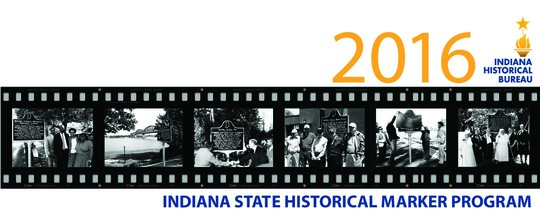
“Chapman
Harris” Indiana State Historical Marker Will
Be Dedicated Near Madison, Indiana
A
public dedication ceremony for an Indiana state historical marker
commemorating Underground Railroad operative Chapman Harris is scheduled for Friday,
November 18, 2016. The marker dedication will begin at 1:00 p.m. at
the intersection of Eagle Hollow Rd. and SR 56 (Ohio River Scenic Byway) just
east of Madison, Indiana, near the Eagle Hollow Marina. Attendees can park at
the campground across the street from the marker, just south of SR 56.
The
text for the “Chapman Harris” marker reads:
Harris,
a free African American, came to Madison, 1839, as the fight over slavery along
the Ohio River became more violent. He worked as a teamster, farmer, and
Baptist minister. His family owned land in Eagle Hollow and Madison. Harris’s
activities to aid enslaved persons crossing the Ohio River at Madison became
widely known throughout Indiana after the Civil War. Harris faced assaults from
slave-catchers; his hostility toward them and their allies led to his arrest
and conviction for causing a riot in Madison, 1847. After the Civil War,
Harris’s influence continued as local political leaders sought his help to
promote allegiance to the Republican Party among newly enfranchised African
American voters. He died in 1890.
You're invited to attend the dedication ceremony for this Indiana state historical marker that examines
race relations along the Ohio River in the years prior to the Civil War and commemorates
Harris’s efforts to aid escaping slaves despite threats to his own safety and
freedom. The dedication will include first-person interpretation, with Lillian
Sue Livers portraying Chapman Harris’s wife, Patsey Ann Allen.
 |
|
IHB would like to thank everyone who submitted Intent to Apply forms and Applications for this year's Marker Program. We received a record number of submissions this year and are excited to begin working on topics that were approved by the Indiana Library and Historical Board at its meeting on October 7.
Interested in applying for a new marker? The next time to apply will be in the spring of 2017. Be sure to check our website and upcoming newsletters for details and deadlines. http://www.in.gov/history/3926.htm
|
Topics Approved by the Board for 2017:
Birthplace of Poet Kenneth Rexroth, St. Joseph Co.
Better Homes of South Bend, St. Joseph Co.
Killing of FBI Special Agent Nelson B. Klein, Union Co.
St. Augustine's Home
for the Aged (Little Sisters of the Poor), Marion Co.
Eugenic Sterilization Program and Law, Clark Co.
Creek Chub Bait Company, DeKalb Co.
Home of Erwin "Cannon Ball" Baker, Marion Co.
Passenger Pigeon, Franklin Co.
Red Skelton, Knox Co.
Caroline Scott Harrison, Marion Co.
Indian Murders in 1824 and the American Justice System (Fall
Creek Massacre), Madison Co.
T.C. Steele Home and Studio, Brown Co.
Demise of German Language Newspapers, Marion Co.
Booth Tarkington, Marion Co.
Madame Walker, Marion Co.
Monrovia: Home of Branch McCracken, Morgan Co.
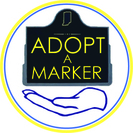 |
|
Hunt
for Hoosier History during Indiana’s Bicentennial
This year, during Indiana’s Bicentennial, IHB is working to
complete a comprehensive survey of every state historical marker installed
across Indiana since the mid-1940s – over 600! Thank you to everyone who has
already submitted photos!
|
We only have a few counties left!
IHB is currently surveying Sullivan, Vigo, Parke, Vanderburgh, and Marion counties and we need your help! If you live, work, or play by an Indiana state historical
marker or come across any in your travels, please snap a few photos and send
them to us at cpfeiffer@history.in.gov or tweet them to us @in_bureau.
Feel free to make it a selfie! You may be surprised at the number of markers you pass each day.
Interested in learning about what markers are in your county?
See our website for more
information. Once there, you can also access additional information on the
marker topic, including marker reviews, detailed annotations, and links to
extra resources.
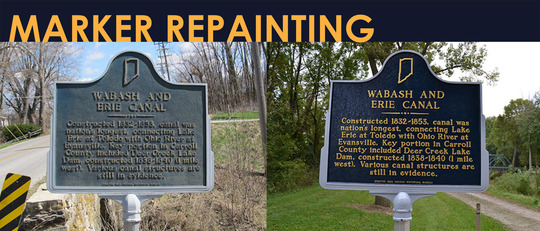 Get Involved!
Looking for a way to get involved during the Bicentennial? Consider repainting one of our state historical markers! IHB has
seen a large increase in the number of groups and individuals interested in
repainting markers this year. We want to extend a big thank you to everyone who
has volunteered thus far and helped us preserve this history for future
generations.
If you are interested in repainting a marker near you, please
contact us at cpfeiffer@history.in.gov. This year’s volunteers have
included county historians, local bicentennial coordinators, school groups,
libraries, 4-H groups, and many individual citizens. Thanks to all!
Thanks!
IHB thanks Bonnie Maxwell, Carroll County Bicentennial Coordinator, and other volunteers in the county for helping to repaint our Wabash and Erie Canal marker (pictured above) and Sycamore Row marker this summer. Thanks to their efforts, these markers have been restored to excellent condition!
 We are lucky to have Annette Scherber as an intern this school year, a fantastic graduate student from the IUPUI Public History. She has written some great posts for the IHB Blog, including:
Charles C. Deam: From Typhoid Survivor to the Great Hoosier Botanist
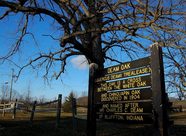 |
|
After
surviving typhoid fever at 16 via an old pioneer remedy of boiled milk
and Old-Field Balsam, Charles Deam's botanist spirit was ignited and
Indiana's forests and fauna never the same.
Learn about Deam's
dedication to Hoosier plant life as a botanist, 1st state forester, and
author (and find out what his "weed wagon" was): blog.history.in.gov/?p=1415
|
 |
|
The most popular fall post from the Indiana Historical Bureau blog was one by Director Chandler Lighty: Lincoln's Forgotten Visit to Indianapolis
Quick,
Abraham Lincoln buffs! Can you name all the dates Lincoln delivered a public
address in Indiana after moving to Illinois in 1830?
Did you
guess February 11 and 12, 1861? That visit occurred during his trip to
Washington to be inaugurated. The next two are probably tougher to
guess. Advanced Lincoln enthusiasts are likely able to identify his visit
to his childhood home in 1844 while campaigning for Henry Clay for president.
A third
visit to Indiana in 1859, the subject of Lighty’s blog post, is largely
forgotten. But, did his address to an Indianapolis audience spur his
ascent to the presidency? Read the blog to find out!
|
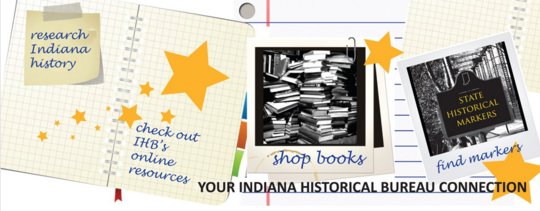
Check out the two posts that our social media followers liked best. Follow us on Facebook, Twitter, and Instagram.
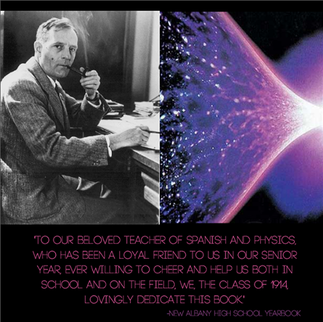 |
|
EDWIN HUBBLE
Did you know that renowned astronomer Edwin Hubble taught at New Albany High
School for the 1913-1914 school year?
The beloved Mr. Hubble instructed students in Spanish, Mathematics, and
Physics. He also oversaw study hall and coached the basketball team. Although
he didn't stay long, he endeared himself to students, inspiring a dedication to
him in their high school yearbook. After trying his hand at teaching, Hubble
went on to change how humans conceive of the universe and is credited as
"the man who discovered the cosmos."
Learn more about the legendary scientist: https://t.co/Rkvxt9RAoL
|
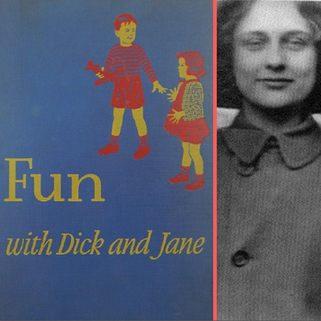 |
|
ZERNA SHARP
Q: Which Hoosier helped nearly 85 million American children learn to read?
A: Zerna Sharp, creator of the iconic Dick and Jane children’s books. The
Hillisburg native taught elementary school in Indiana, before taking a job as a
textbook consultant. Sharp believed children were expected to learn too many
new words at once, which discouraged their interest in reading. She created the
Dick and Jane illustrated primers, which followed the adventures of a brother
and sister. Children she observed playing on the beach in Chicago inspired the
dialogue and plot, making the tales realistic for her young readers. Schools
used these books widely from the 1930s through the 1970s.
Learn more about the Sharp Hoosier: http://nyti.ms/2cmMUHi
|
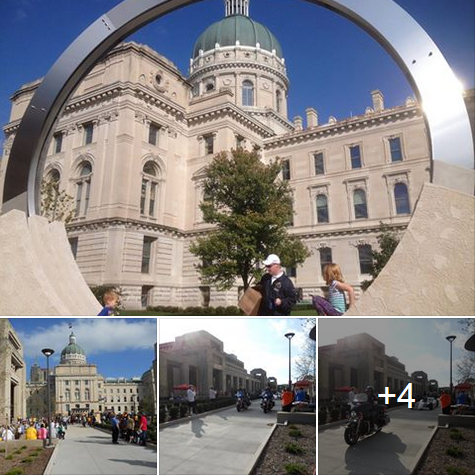 Hoosier Homecoming
On October 15, as a part of the bicentennial celebration, IHB participated in the Hoosier Homecoming. We were there for the dedication of the Bicentennial Plaza and the Statehouse Education Center in the State Library, and to celebrate the Bicentennial Torch Relay. We met many of you in the plaza where we were set up with items from the IHB Shop (which is now online!). But that's not all...
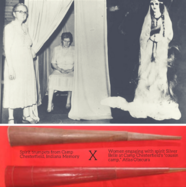 |
|
IHB Historians Present
At the homecoming event, IHB historians presented talks at the Indiana State Library on a range of subjects from Abraham Lincoln to Hoosier basketball to 19th-century spiritualism. IHB Outreach Coordinator Lindsey Beckley presented her talk on Camp Chesterfield to an interested audience - a perfect lead-in to Halloween! You can read the blog post based on her research on Blogging Hoosier History.
|
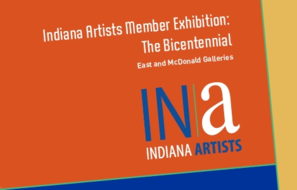 |
|
On October 4, IHB Research &
Digital Content Editor Nicole Poletika spoke at the Art Museum of Greater
Lafayette as part of the museum’s bicentennial gallery series. She discussed
the history of the Indiana State Flag, including why it was not
recognized by Hoosiers for decades, and how it symbolized home in wars abroad.
|
She also informed the audience about the life and artistic career of the flag’s
designer Paul Hadley, of Mooresville. The talk was followed by a viewing of the
banner. Check out IHB’s new Indiana State Flag marker
and learn more about its history: http://www.in.gov/history/markers/4308.htm
PHOTO: Indiana State Representative,
Shelia Klinker; Kendall Smith, Executive Director, Art Museum if Greater
Lafayette; Indiana State Senator, Ron Alting, courtesy of Susan Chavers.

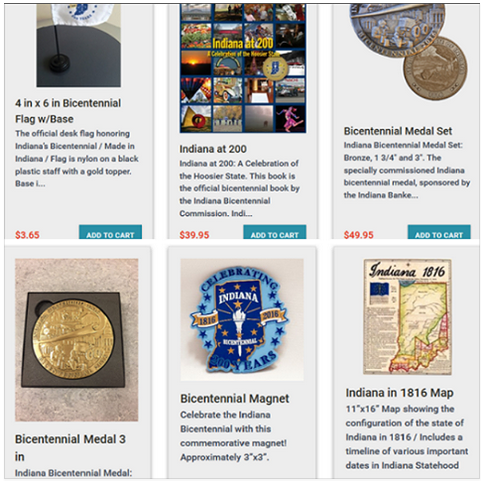  You can now shop and check out online at: shop.history.in.gov!
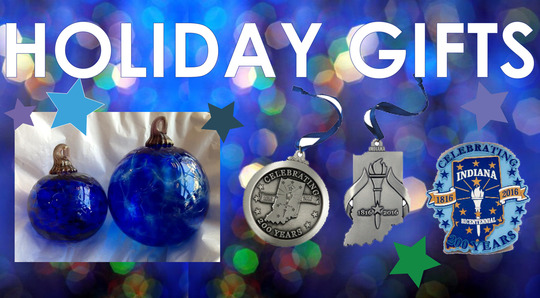
The IHB Gift Shop has something for everyone on your holiday
shopping list! For bicentennial souvenirs, ornaments, hand blown glass, and
more visit our shop in the Indiana State Library or our online shop at
shop.history.in.gov!
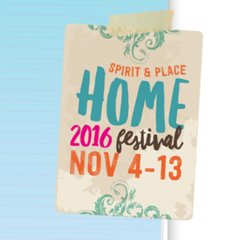 |
|
Spirit & Place
The Spirit & Place Festival aims to be a catalyst for civic engagement through creative collaborations among the arts, humanities, and religion. This Saturday, November 12, Indiana Historical Bureau director Chandler Lighty will present an interactive experience using Hoosier State Chronicles. The day will also include the opportunity to learn about and participate in IUPUI's project Chronicling Hoosier.
Chronicling
Hoosier will provide avid “Hoosier” hunters, burgeoning genealogists,
and the just plain curious equal delight in discovering the power of
digital historic newspapers. Learn more from Spirit & Place.
|

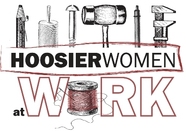 |
|
Hoosier Women at Work: Science, Technology, and Medicine
Building
on the success of last year’s Hoosier Women at Work conference, IHB and
the Indiana State Library will host “Hoosier Woman at Work," a women’s
history symposium, on April 1, 2017.
|
This one-day conference
explores and expands our knowledge of women’s contributions to Indiana’s
science, technology, and medical fields via speakers, presentations,
and panel discussions. Graduate students can win a $500 prize for best
original scholarship. (Undergraduates are also encouraged to apply).
PAPER PROPOSALS DUE DECEMBER 1
Learn how to submit your proposal: in.gov/history/4305.htm
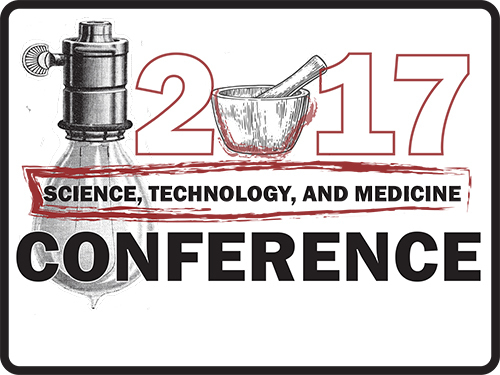
|

































